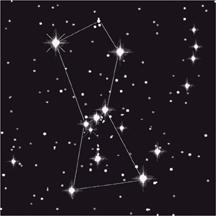Orion the Hunter
Hunters today view the darkened predawn skies with anticipation of the coming hunt. The ancient Greeks also gazed up at the same infinite darkness, hoping for a successful hunt and noting that one pattern of stars this time of year seemed to resemble a giant hunter carrying a club and wearing a sword suspended from a belt. They named the constellation Orion.
In Greek mythology, Orion was a hunting companion of the huntress-goddess Artemis. In some versions of this story, Artemis killed Orion. Then her father, Zeus, the king of the gods, immortalized the giant huntsman by placing him in the sky as a constellation.
Orion is one of the largest, most conspicuous, and most readily identifiable constellations in the night sky. The three bright stars in Orion’s belt are "The Three Kings": Zeta Orionis, which is the eastern-most star and actually is a triple star; Epsilon Orionis, which is the middle star and one of the brightest stars in the night sky; and Delta Orionis, which is actually a multiple star at the western end of Orion's belt.
Hanging from Orion's belt in a southerly direction is his sword, including Iota and Theta Orionis. Iota Orionis, at the tip of the sword, is actually a quadruple star system. But Theta Orionis is not a star at all—the bright bluish-pink object in the sword of Orion is actually the brightest part of the Orion Nebula.
The star in the middle of Orion's sword, the Orion Nebula, is one of the most photographed objects in the night sky and is among the most intensely studied celestial features. The nebula appears fuzzy to sharp-eyed observers; even the Mayans noted this “diffuse” or “smudged” star without the aid of telescopes. A close view reveals a central group of stars called the Trapezium surrounded by wisps of nebulous material: swirling clouds of nascent stars, luminous gas, and dust. Around the Trapezium, more than 3,000 stars fill out the nebula.
In 1617, Galileo described many elements of the constellation Orion, including the Trapezium, but he did not identify the Orion Nebula. Some authors have speculated that this oversight was the result of the limitations of his “Galilean-Type” telescope. More recent astronomers have used the Hubble Space Telescope to capture incredibly detailed views of this spectacularly photogenic object. This nebula is an example of a stellar nursery, where more than 700 new stars are “being born” from intense and turbulent motions of gas, protoplanetary disks, brown dwarf stars, and the photo-ionizing effects of massive stars.
With Orion, as with many natural objects, the more closely you look, the more details you see. Happy hunting!






